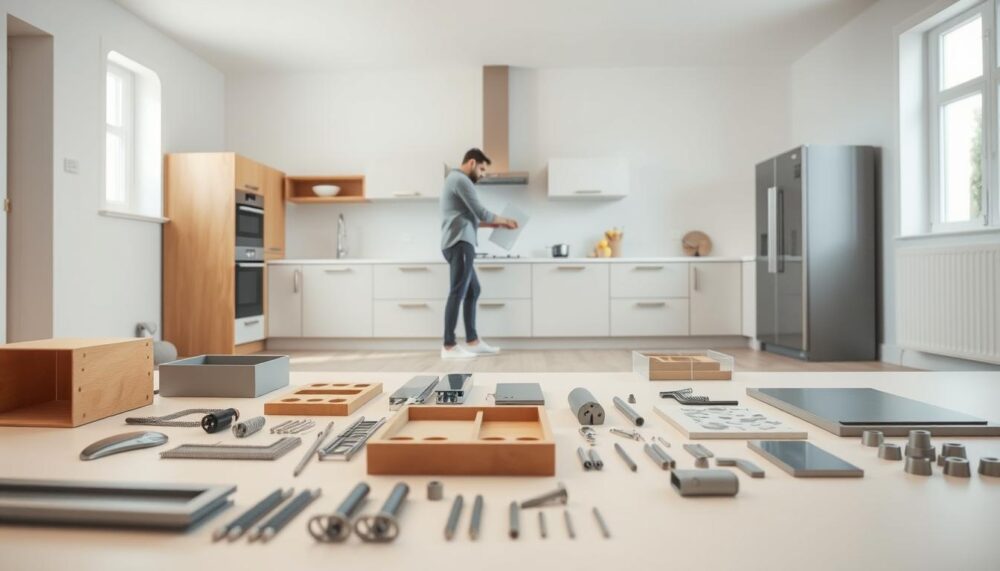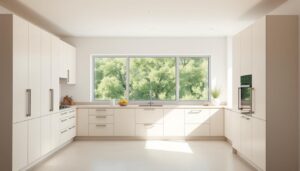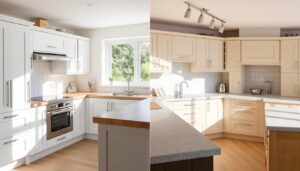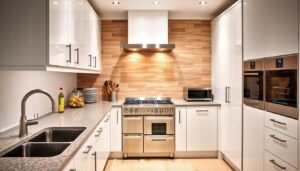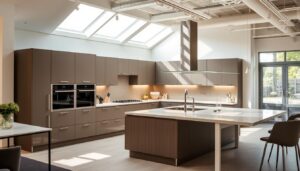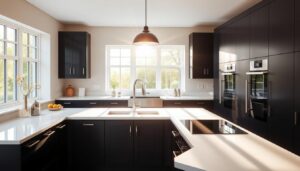If you’re planning a kitchen renovation, you might wonder whether B&Q units arrive ready to install. The short answer is no—these kitchens are supplied as flat pack, meaning you’ll need to assemble them yourself. This approach differs from suppliers like Howdens, which offer pre-built cabinets.
Choosing a flat pack option can save money, but it requires time and effort. For example, one customer was quoted £800 for B&Q units versus £2,700 for professional installation elsewhere. This price gap highlights the trade-off between cost savings and convenience.
Before committing, consider your DIY skills and schedule. While self-assembly cuts expenses, fitting services ensure precision. We’ll explore the process, installation options, and tips to help you decide.
Key Takeaways
- B&Q kitchens require assembly as they come in flat pack form.
- Howdens provides pre-assembled units for easier installation.
- Flat pack options can significantly reduce costs compared to fitted services.
- DIY assembly demands time and basic skills.
- Professional fitting ensures accuracy but increases expenses.
Understanding B&Q Kitchens: Flat Pack or Ready-Made?
Flat pack kitchens offer flexibility, but are B&Q’s options pre-built or DIY? Unlike some competitors, B&Q supplies units as flat pack—similar to IKEA wardrobes—where you assemble the pieces yourself. This approach differs from suppliers like Howdens, which deliver pre-constructed cabinets.
What Is a Flat Pack Kitchen?
A flat pack kitchen arrives as unassembled panels and fittings, designed for DIY assembly. Think of it like puzzle pieces: you follow instructions to build cabinets, shelves, and drawers. This method cuts price by 30–50% compared to pre-built units, as you’re paying for materials, not labour.
Are B&Q Kitchens Flat Pack or Pre-Assembled?
B&Q exclusively sells flat pack units, while Howdens provides ready-made options. A contractor noted,
“Flat pack means higher fitting charges if you hire help, but the space savings during transport are a plus.”
For example, a 10-unit L-shaped kitchen takes roughly two days to assemble.
Benefits of Choosing a Flat Pack Kitchen
Opting for flat pack brings several advantages:
- Cost savings: Significant reductions versus pre-assembled IKEA kitchens.
- Easier transport: Unbuilt units fit in compact cars or tight space.
- Customisation: Mix-and-match components for a tailored layout.
- Eco-friendly: Less packaging waste than pre-built alternatives.
| Feature | B&Q (Flat Pack) | Howdens (Pre-Assembled) |
|---|---|---|
| Price | £1,200 (10-unit example) | £2,700 (similar setup) |
| Assembly Time | 2 days | None |
| Transport | Fits in small vehicles | Requires van delivery |
| Materials | MDF/laminate options | Solid wood upgrades |
While flat pack demands effort, the advantage lies in affordability and adaptability. Assess your DIY skills and project timeline before choosing.
Do B&Q Kitchens Come Assembled? The Assembly Process Explained
Putting together a flat pack kitchen requires patience, but the savings make it worthwhile. Unlike pre-built options, you’ll need to dedicate time to assemble each unit. Here’s how to navigate the process smoothly.
What to Expect When Your Kitchen Arrives
Your delivery will include multiple boxes filled with panels, hinges, and screws—typically 30+ component bags per unit. Label each part as you unbox to avoid confusion later. One first-time DIYer shared:
“I spent an hour organising screws before starting—it saved me hours of frustration.”
https://www.youtube.com/watch?v=G7CSRVq3Q1c
Tools and Skills Needed for Assembly
Basic DIY skills and the right tools are essential. Here’s what you’ll need:
- Electric screwdriver: Speeds up the process significantly.
- Spirit level: Ensures cabinets are perfectly aligned.
- Silicone gun: For sealing edges against moisture.
| Tool | Purpose | Time Saved |
|---|---|---|
| Electric screwdriver | Fixing panels | 2 hours/unit |
| Spirit level | Aligning units | Prevents rework |
| Silicone gun | Waterproofing | 5 mins/joint |
B&Q’s Support: Instructions and Tutorials
B&Q provides detailed instructions and 27 YouTube tutorials. Common pitfalls like misaligned hinges are covered step-by-step. For complex tasks like worktop cutting, consider hiring a professional.
Safety note: Always secure tall units to walls to prevent tipping, especially if fitting heavy appliances.
B&Q Kitchen Installation Services: What’s Included?
Professional installation can save time and stress—but what exactly does B&Q provide? Their services cater to varying needs, from basic fitting to full project management. Below, we explore the options, costs, and hidden details to help you decide.
Overview of Installation Options
B&Q offers three service tiers:
- Basic Installation (£1,837+): Covers unit assembly, appliance plumbing, and alignment. Excludes flooring or tile removal.
- Design Service (£50 refundable): Planning support with a specialist.
- Full Project Management: Coordinates electricians, plumbers, and timelines for seamless execution.
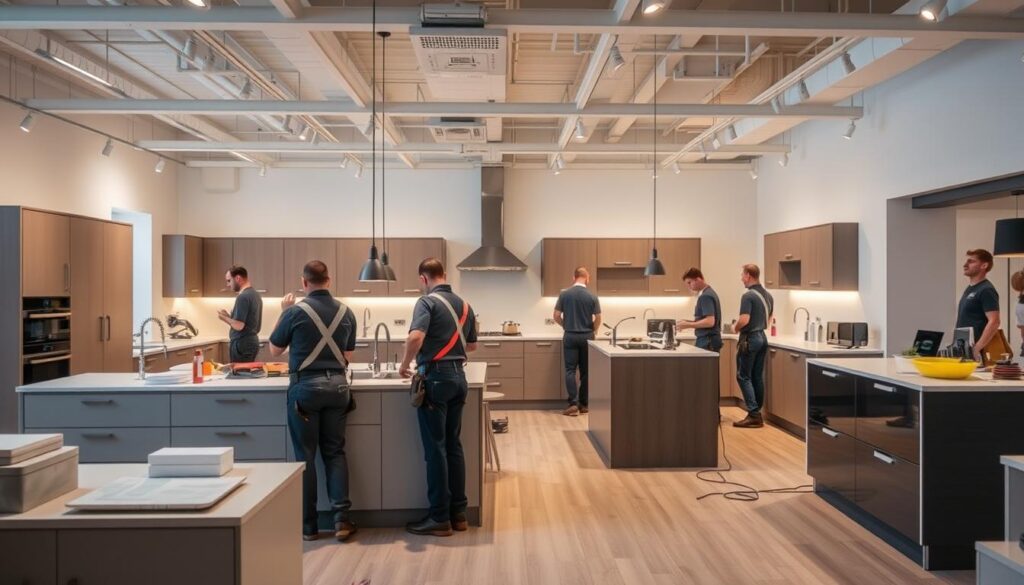
Cost Breakdown: Basic vs. Full Management
A 2023 quote revealed a £2,700 full-service package, including gas surveys. Hidden fees like £300 for surveys can add up. Compare tiers below:
| Service | Cost Range | Inclusions | Timeline |
|---|---|---|---|
| Basic | £1,837–£2,200 | Units, plumbing | 5–7 days |
| Full Management | £2,700+ | Gas surveys, trades coordination | 1–2 weeks |
Is Professional Installation Worth It?
For complex jobs, yes. One customer saved £900 by handling demolition themselves but hired B&Q for fitting. The charge for precision and speed often justifies the cost, especially with warranties backing the work.
Tip: Always request a detailed quote to avoid surprises like flooring prep fees.
DIY vs. Professional Installation: Which is Right for You?
Deciding between DIY and professional installation for your kitchen project involves weighing costs, skills, and time. While self-assembly saves money, hiring a kitchen fitter ensures precision. Below, we break down the factors to help you choose the best way forward.
Pros and Cons of Assembling Your Kitchen Yourself
DIY assembly cuts cost by £1,500+ on average, but demands effort. Steve, a homeowner from Leeds, shared:
“I saved £2,000 building my units, but the splashback tiling took three attempts. Patience is key!”
Consider DIY if you:
- Have basic skills (levelling cabinets, drilling).
- Can dedicate 2–3 days to assembly.
- Want to rent tools like mitre saws (£22/day).
Risks: Misaligned units or plumbing errors may increase long-term cost.
When to Consider Hiring a Kitchen Fitter
Professionals guarantee quality and speed. A London contractor noted:
“Fitters prevent costly mistakes—like uneven worktops that ruin suppliers‘ warranties.”
Opt for a fitter (£25–£40/hour) if:
- Your design includes complex plumbing or electrical work.
- You lack tools or time (fitters complete jobs in 5–7 days).
- Suppliers require certified installation for warranties.
Tips for Saving Money on Your Kitchen Project
A hybrid way balances savings and quality. Examples:
- Assemble units yourself, then hire a fitter for technical tasks.
- Reuse existing plumbing layouts to cut labour cost.
- Compare suppliers—some offer discounts for bulk purchase.
Warning: Some fitters refuse customer-assembled units. Clarify this before hiring.
Conclusion
Choosing between DIY and professional installation for your kitchen depends on budget, time, and skills. B&Q units require assembly, but the advantage lies in lower prices and flexible design options. As one contractor noted, “Flat pack isn’t cheaper if you value your time.”
Before deciding, weigh these factors:
- Time: Self-assembly takes 2–3 days versus 5–7 days with a fitter.
- Budget: DIY saves £1,500+ but risks errors.
- Skills: Complex tasks like plumbing may need professionals.
For a smoother process, compare quotes from suppliers like Howdens or IKEA. Download our free kitchen planning guide for layout tips and maintenance advice.
Got a DIY disaster story? Share it below—even experts make mistakes!
FAQ
What is a flat pack kitchen?
A flat pack kitchen comes in unassembled units, requiring some DIY skills to put together. These cabinets and fittings are packed flat, making them easier to transport and store before installation.
Are B&Q kitchens flat pack or pre-assembled?
Most B&Q kitchens are supplied as flat pack, meaning you’ll need to assemble them yourself or hire a professional. However, some larger items like appliances may come ready to install.
What are the benefits of choosing a flat pack kitchen?
Flat pack kitchens often cost less than pre-assembled ones, giving you more control over the design. They’re also easier to transport and can be adjusted to fit tricky spaces.
What tools and skills are needed to assemble a B&Q kitchen?
Basic DIY tools like a drill, screwdriver, and spirit level are essential. If you’re not confident, hiring a kitchen fitter ensures a smooth installation.
Does B&Q offer installation services?
Yes, B&Q provides professional installation services. You can choose between basic fitting or a full project management service, depending on your budget and needs.
How much does B&Q charge for kitchen installation?
Prices vary based on the size of your project and the services you select. Getting a quote from B&Q will give you a clearer idea of costs.
Is professional installation worth the extra cost?
If you lack DIY experience, hiring a professional ensures a high-quality finish and saves time. It also reduces the risk of mistakes that could cost more to fix later.
Can I save money by assembling my B&Q kitchen myself?
Yes, DIY assembly cuts labour costs. However, consider your skill level—mistakes in fitting cabinets or appliances could lead to extra expenses.
Where can I find assembly instructions for my B&Q kitchen?
B&Q provides detailed guides and online tutorials to help with assembly. Customer support is also available if you need assistance.

